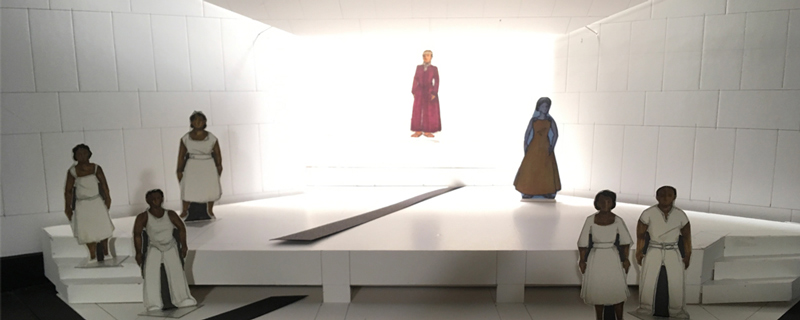Creating the World of OEDIPUS REX

We talked with scenic designer John Culbert to learn more about his approach to designing sets and the design for OEDIPUS REX. The following interview is edited from his responses.
How do you approach designing sets for theatre?
The “set” for a theatre production defines the world in which we are going to tell the story. Before the performance even starts, it can give clues to the nature of the story to be told. If the set is literal, realistically depicting a location we recognize, we expect real-time, characters, and behavior in the performance. If the set is abstracted in some way, we expect some aspect of the performance will also not be “real.” So, before we can create the world, the production team needs to define the nature of the storytelling, which will then steer the set into a direction. In any case, we typically start with literal research about the locations in the play. We also look at images created by other visual artists inspired by themes, periods, or contexts that are addressed in the play. The inspiration for the world can come from any of that research, in addition to personal experience. There are usually many ideas resulting from the understanding gained through the research. So, we typically look at a number of options. Once we select a direction, refinement of that idea happens to support the action of the play.
Over a number of years, the work we’ve done with director Charlie Newell tends to explore non-literal ways of representing the world. It is our experience that this empowers the audience to apply their own experiences and thoughts about the world rather than us telling them every detail. It inspires engagement rather than “watching.”
Did your approach change when starting to think about Oedipus Rex?
We followed our typical process of literal research (classic Greek architecture, altars, entrances/stairs, Greek theatres, shrines, etc.) and also performed visual image research that captured a sense of a place of power. That led us to light artist James Turrell and his work ended up serving as direct inspiration for the world we created. What was atypical in the process was that all of the artists working on the entire three–play Greek cycle being produced by Court were part of the design conversations. This collaboration added an unusual richness to the conversation with more perspectives and ideas in the hopper.
What are some of your overarching goals for Oedipus‘ scenic design?
We wanted to establish a place of power (in literal terms, we are just outside the seat of power in Thebes). We also knew that we wanted to create a space to support the telling of the story of Oedipus, not a representation of the literal location of the action in the play. We wanted a space that can transform with light in order to be able to go on the incredible emotional journey of the play. We wanted to set up the concept of the Chorus supporting the emotional journey of Oedipus, not a chorus of Thebes townsfolk. And, we wanted a space that will empower dynamic movement, as that is an important aspect of how we will tell the story.
How much of your work has been informed by the rest of The Oedipus Trilogy?
It has been strongly informed by the input of the artists working on the other two plays in the cycle, as they were part of the design conversations. And, we thought about how the environments of the different plays should relate conceptually. We thought about how to connect the end of Oedipus with the beginning of Gospel at Colonus in terms of the journey of Oedipus. So, there are conceptual connections but not literal mirroring of the worlds.
What’s been the most challenging/rewarding aspect of designing the set for Oedipus?
A challenge in creating a world for this story of Oedipus is how to create a space that has the scope and scale that enables the range of emotion and human journey that the story creates. We strive to enhance, rather than diminish, how far the audience can go in their empathy with this, the most tragic of human journeys.
What’s something you wish audience members knew about scenic design?
I do not think they need to know much about the technicalities of set design—I just hope they bring their imagination to the theatre and that we can then inspire them to use it fully!
Previews to OEDIPUS REX begin November 7. Learn more about the production →